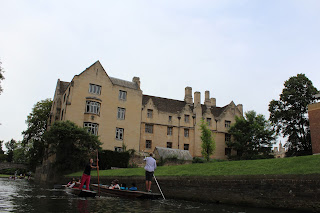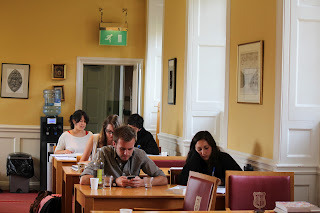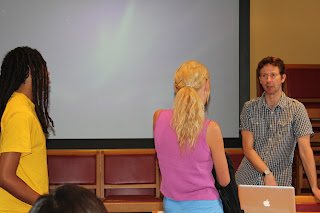The River Cam started out as an important trade route long before the first scholars, who were fleeing from riots at Oxford, arrived in 1209 to establish the first college, Peterhouse. Before then, the bridge over the River Cam was strategically important because it was a major route for Romans, Danes and Norman invaders that could be reached from the coast and inland. Hence the eventual name for the hill area overlooking the Cam: Cambridge. Clare College, where we are staying, was the second college founded, dated 1326. The next college was King's College in 1441, followed by Queens' College in 1448, and so on, until 31 colleges were established. Trinity College, founded in 1546, holds the most Nobel Prize winning students and researchers: 33. There are 88 Nobel Prize winners altogether from Cambridge.
Now, instead of functioning as a major trade route, the River Cam is popular for recreation, such as "punting." There is an annual Oxford v. Cambridge Boat Race held since 1829, which Cambridge won for the last two years in a row. Punts are flat-bottom boats that were used centuries ago in the river's shallow waters to transport goods on the Cam. Now, they are used recreationally on the river and are mostly "chauffeured" by young men who narrate the history of Cambridge and its colleges for about 40-45 minutes. You can try to steer your own punt, but the results are more comical than successful.
Mark and I went punting, sharing the punt with two young ladies also visiting Cambridge, and rowed by young David, our guide through the River Cam, the history of Cambridge, and interesting anectodal stories of this area. So, let's go punting:
 |
| David, the punt driver |
 |
| Punt jam on the Cam |
 |
| David can talk and duck at the same time! |
 |
| This and other photos are of the old colleges and buildings. |
 |
| The Bridge of "Sighs" designed in 1831. |
 |
The Magdalene Bridge - the only steel bridge over the Cam -
and it is the site of the original Cam Bridge |
 |
St. John's New Court, built in 1831. Said to be so favored
by Adolph Hitler that he planned it as his residence
after he occupied England. Thus, Cambridge was spared
bombing by Germany during WWII. |
 |
King's Chapel at King's College. During WWII, the beautiful
stained glass window was disassembled to protect it in case of
bombs. Unfortunately, they failed to map the original stain glass design,
so it took them 12 years to return the pieces to their original settings. |
 |
Too crowded on the Cam! Those crazy tourists think
they can steer their own punts! |
 |
This is the "Mathematical Bridge," designed by Isaac Newton.
Said to have been originally assembled without any nails or screws
and that the weight of the travelors over the bridge would make
it even stronger. It was disassembled once and then reassembled
but with screws to prevent being re-disassembled. |
 |
| Hi, Carole! She's punting on the Cam! |
 |
Clare Bridge -- we travel over this bridge every day!
Thank you, David, for our trip down the Cam. |





















































